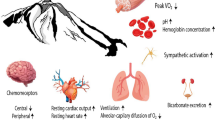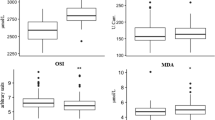Abstract
Exercise-induced increase in oxygen consumption leads to oxidative stress. On the contrary, hypoxia triggers oxidative stress despite decreased oxygen flux. Therefore, exercise under hypoxia may aggravate oxidative damage. Highlanders are expected to have better antioxidant capacity than lowlanders as a result of adaptation to hypoxia. The present study was undertaken to investigate the effect of exercise on antioxidant system in lowlanders and highlanders at high altitudes (HA). This study was conducted on active male volunteers, randomly selected and categorized into three groups, i.e., lowlanders tested at sea level (LL-SL, n = 35), lowlanders tested at altitude of 4560 m (LL-HA, n = 35) and native highlanders tested (HAN, n = 20) at the same height. Volunteers performed maximal exercise until exhaustion. Blood samples were collected before and after exercise. Both LL-SL and HAN had shown similar VO2max, which was significantly higher than LL-HA. GSH/GSSG ratio significantly increased in LL-SL and decreased in HAN after exercise. With exercise there were a decrease in superoxide dismutase and increase in glutathione peroxidase and catalase activities in HAN. Therefore, the results have suggested that HAN are more susceptible to oxidative stress when subjected to high-intensity exercise than lowlanders. The cumulative effect of higher VO2max and longer duration of exercise in hypoxia may be the reason of higher level of oxidative insult among HAN. Comparatively better management of antioxidant system observed in lowlanders at HA may be explained by the lower VO2max and shorter duration of exercise in hypoxia.


Similar content being viewed by others
References
Aebi H (1984) Catalase in vitro. In: Packer L (ed) Methods in enzymology. Academic Press Inc, Florida
Askew EW (2002) Work at high altitude and oxidative stress: antioxidant nutrients. Toxicology 180:107–119. doi:10.1016/S0300-483X(02)00385-2
Bailey DM, Davies B, Young IS (2001a) Intermittent hypoxic training: implications for lipid peroxidation induced by acute normoxic exercise in active men. Clin Sci (Lond) 101:465–475. doi:10.1042/CS20010065
Bailey DM, Davies B, Young IS, Hullin DA, Seddon PS (2001b) A potential role for free radical mediated skeletal muscle soreness in the pathophysiology of acute mountain sickness. Aviat Space Environ Med 72:513–521
Beall CM, Decker MJ, Brittenham GM, Kushner I, Gebremedhin A, Strohl KP (2002) An Ethiopian pattern of human adaptation to high altitude hypoxia. Proc Natl Acad Sci USA 99:17215–17218. doi:10.1073/pnas.252649199
Chevion S, Moran DS, Heled Y, Shani Y, Regev G, Abbou B, Berenshtein E, Stadtman ER, Epstein Y (2003) Plasma antioxidant status and cell injury after severe physical exercise. Proc Natl Acad Sci USA 100:5119–5123. doi:10.1073/pnas.0831097100
Clarkson PM, Thompson HS (2000) Antioxidants: what role do they play in physical activity and health? Am J Clin Nutr 72:637–646
Davies KJA, Quintanilha TA, Brooks GA, Packer L (1982) Free radical and tissue damage produced by exercise. Biochem Biophys Res Commun 107:1198–1205. doi:10.1016/S0006-291X(82)80124-1
Fatokun AA, Stone TW, Smith RA (2007) Hydrogen peroxide mediates damage by xanthine and xanthine oxidase in cerebellar granule neuronal cultures. Neurosci Lett 416:34–38. doi:10.1016/j.neulet.2007.01.078
Frisancho AR (1975) Functional adaptation to high altitude hypoxia. Science 187:313–319. doi:10.1126/science.1089311
Ge RL, Shen QH, Wang LH, Gen D, Yang P, Hugo K, Fujimoto K, Matsuzawa Y, Yoshimura K, Takeoka M, Kobbayashi T (1994) Higher exercise performance and lower VO2max in Tibetan than Han residents at 4700 m altitude. J Appl Physiol 77:684–691
Hissin PJ, Hilf R (1976) A fluorometric method for determination of oxidized and reduced glutathione in tissues. Anal Biochem 74:214–226. doi:10.1016/0003-2697(76)90326-2
Jenkins RR, Krause K, Schofield LS (1993) Influence of exercise on clearance of oxidant stress products and loosely bound iron. Med Sci Sports Exerc 80:611–618
Ji LL (1995) Exercise and oxidative stress: role of the cellular antioxidant systems. In: Holloszy JO (ed) Exercise sport science reviews. Williams & Wilkins, USA
Ji LL (1999) Antioxidants and oxidative stress in exercise. Proc Soc Exp Biol Med 222:283–292. doi:10.1046/j.1525-1373.1999.d01-145.x
Ji LL (2002) Exercise induced modulation of antioxidant defence. Ann N Y Acad Sci 959:82–92
Ji LL, Fu RG, Mitchell E (1992) Glutathione antioxidant enzyme skeletal muscle: effect fiber type exercise intensity. J Appl Physiol 73:1854–1859
Joanny P, Steinberg J, Robach P, Richalet JP, Gortan C, Gardette B, Jammes Y (2001) Operation Everest III (Comex’97): the effect of simulated severe hypobaric hypoxia on lipid peroxidation and antioxidant defence system in human blood at rest and after maximal exercise. Resuscitation 49:307–314. doi:10.1016/S0300-9572(00)00373-7
Kanter MM, Notle LA, Holloszky JO (1993) Effects of an antioxidant vitamin mix on LPO at rest and post exercise. J Appl Physiol 74:965–969
Kong O, Lillehei KO (1998) Antioxidant inhibitors for cancer therapy. Med Hypotheses 51:405–409. doi:10.1016/S0306-9877(98)90036-6
Leeuwenburgh C, Ji LL (1995) Glutathione depletion in rested and exercised mice: biochemical consequence and adaptation. Arch Biochem Biophys 316:941–949. doi:10.1006/abbi.1995.1125
Leeuwenburgh C, Ji LL (1996) Alteration of glutathione and antioxidant status with exercise in unfed and refed rats. J Nutr 126:1833–1843
Lekhi C, Gupta PH, Singh B (2007) Influence of exercise on oxidant stress products in elite Indian cyclists. Br J Sports Med 41:691–693. doi:10.1136/bjsm.2007.037663
Link EM, Riley PA (1998) Role of hydrogen peroxide in the cytotoxicity of the xanthine/xanthine oxidase system. Biochem J 249:391–399
Marconi C, Marzorati M, Cerretelli P (2006) Work capacity of permanent residents of high altitude. High Alt Med Biol 7:105–114. doi:10.1089/ham.2006.7.105
Mastaloudis A, Leonard SW, Traber MG (2001) Oxidative stress in athletes during extreme endurance exercise. Free Radic Biol Med 31:911–922. doi:10.1016/S0891-5849(01)00667-0
Meister A (1994) Glutathione-Ascorbic acid antioxidant system in animals. J Biol Chem 269:9397–9400
Mena P, Maynar M, Gutierrez JM, Maynar J, Timon J, Campillo JE (1991) Erythrocyte free radical scavenger enzymes in bicycle professional racers: adaptation to training. Int J Sports Med 12:563–566. doi:10.1055/s-2007-1024734
Moller P, Loft S, Lundby C, Olsen NV (2001) Acute hypoxia and hypoxic exercise induce DNA strand breaks and oxidative DNA damage in humans. FASEB J 15:1181–1186. doi:10.1096/fj.00-0703com
Nyyssonen K, Sarataho EP, Kaikkonen J, Jukka T (1997) Ascorbate and urate are the strongest determinants of plasma antioxidative capacity and serum lipid resistance to oxidation in Finnish men. Atherosclerosis 130:223–233. doi:10.1016/S0021-9150(96)06064-9
Ohno H, Yahata T, Sato Y, Yamamura K, Taniguchi N (1988) Physical training and fasting erythrocyte activities of free radical scavenging enzyme systems in sedentary men. Eur J Appl Physiol 57:173–176. doi:10.1007/BF00640658
Ortenblad N, Madsen K, Djurhuuus MS (1997) Antioxidant status and lipid peroxidation after short term maximal exercise in trained and untrained humans. Am J Physiol 272:R1258–R1263
Racker E (1955) Glutathione reductase from baker’s yeast and beef liver. J Biol Chem 217:855–865
Sahlin K, Ekberg K, Cizinsky S (1991) Changes in plasma hypoxanthine and free radical markers during exercise in man. Acta Physiol Scand 142:273–281. doi:10.1111/j.1748-1716.1991.tb09157.x
Sen CK (1995) Oxidants and antioxidants in exercise. J Appl Physiol 79:675–686
Sen CK, Atalay M, Hanninen O (1994) Exercise induced oxidative stress: glutathione supplementation and deficiency. J Appl Physiol 77:2177–2187
Sinha S, Singh SN, Ray US (2009) Total antioxidant status at high altitude in lowlanders and native highlanders: role of uric acid. High Alt Med Biol (Accepted)
Wagner PD (2000) Reduced maximal cardiac output at high altitude-mechanisms and significance. Respir Physiol 120:1–11. doi:10.1016/S0034-5687(99)00101-2
Waring WS (2002) Uric acid: an important antioxidant in acute ischemic stroke. Q J Med 95:691–693
Winkler BS (1987) In vitro oxidation of ascorbic acid and its prevention by GSH. Biochim Biophys Acta 925:258–264
Winkler BS, Orselli SM, Rex TS (1994) The redox couple between glutathione and ascorbic acid: a chemical and physiological perspective. Free Radic Biol Med 17:333–349. doi:10.1016/0891-5849(94)90019-1
Wolff SP (1994) Hydroperoxide measurement by FOX. In: Packer L (ed) Methods in enzymology. Academic Press Inc, California
Zannoni V, Lynch M, Goldstein S, Sato P (1974) A rapid micromethod for determination of ascorbic acid in plasma and tissue. Biochem Med 11:41–48. doi:10.1016/0006-2944(74)90093-3
Acknowledgments
Authors are grateful to the Director of Defence Institute of Physiology and Allied Sciences (DIPAS), Delhi, India, for providing necessary support and for showing keen interest in this study. The authors also thank Dr. Y.K.Sharma, Scientist ‘E’ of this institute, for all statistical analysis, especially Mr. Deepak Das, Senior Technical Assistant, and Mrs. Anjana Pathak, Technical Officer, for all necessary technical support. Thanks are due to soldiers who volunteered for the study and authorities of Indian Army for logistic support for field study.
Author information
Authors and Affiliations
Corresponding author
Rights and permissions
About this article
Cite this article
Sinha, S., Ray, U.S., Saha, M. et al. Antioxidant and redox status after maximal aerobic exercise at high altitude in acclimatized lowlanders and native highlanders. Eur J Appl Physiol 106, 807–814 (2009). https://doi.org/10.1007/s00421-009-1082-x
Accepted:
Published:
Issue Date:
DOI: https://doi.org/10.1007/s00421-009-1082-x




